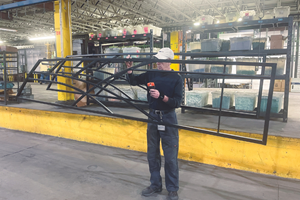What Caused the White Spots?
Why are there white spots on the powder coated railing?
Q. My husband and I have a small custom iron shop in Oakville, Ontario. We recently had two problems with a job that was powder coated. The first problem occurred at a 16-unit townhouse where we fabricated and installed a railing for them last January. They have gradually begun to show a large number of white spots all around the railing. The railing was fabricated of galvanized steel and with black powder coating. We have asked the powder coater that did the job for us to explain what the white spots are and they said they used the best color product and are unsure of what is causing the spots. Recently, another customer of ours that has an installation on the same street installed around the same time as the other installation called and complained about the same white spots on her railing. I really don’t know what the reason is. We paid another source to do the powder coating for us and now we have to fix these problems. This is a lot of extra cost for our company. Can you please explain what it is, why we have this problem and a possible solution? We are hoping for a cheap and easy fix to the problem. We tried to remove the spots with a scotch-brite pad, but it did not work.—M.M.
A. Galvanized steel is used to provide a zinc layer between steel that has been dipped in a molten zinc bath and the corrosive moisture of an outdoor environment. Zinc is a much more reactive metal than iron so it oxidizes readily when exposed to water and oxygen. That prevents the moisture from penetrating the zinc layer and exposing the iron to red rust. Galvanized steel can powder coat like most metals, but it has to be prepared properly to prevent adhesion loss and it has to have a sufficient layer of powder to prevent moisture penetration. If the metal is not prepared properly or the powder layer is too thin, the zinc can be exposed to excess moisture and will develop “white rust.” The oxidizing zinc layer will begin to break down the powder layer and ruptures of oxidation will show on the outer layer of the film. They are small at first, but they will get bigger as more and more substrate is exposed to moisture and the powder coating will continue to break down in the affected area.
Those white spots are corrosion cells under the coating. The metal was not prepared as well as it needed to be and the coating is likely too thin. Moisture has been able to penetrate the coating and initiate oxidation. Before powder coating hot-dipped galvanized steel, it is a good idea to do a light blast to remove oxidation and mineral build up on the surface. Some deposits may have been left on the surface. It appears that no conversion coating was used and you likely did not have enough powder film thickness.
Unfortunately, there is no cheap and easy way to fix it. The coating will have to be stripped to the bare metal and treated correctly:
- Strip the coating
- Brush-Blast the surface to remove all residual coating and soil (NACE 4)
- If the blast is clean enough (all soil and dust removed), use one layer of zinc rich powder primer and one layer of Super-Durable polyester black
- If you cannot prime, you must pretreat the part by washing and applying a zinc phosphate or similar quality conversion coating.
One of the key reasons for powder coating failure is a lack of total process understanding. First of all, understand your substrate material. What is the surface condition and what will it take to promote initial adhesion and prevent corrosion? Second, you must consider where it will be used and determine how aggressive the surrounding environment will be. That will dictate the type of pretreatment and coating combination that you must use to get the planned performance results. Powder coating is a process that must have the right steps to provide the performance needed. One coat of powder may be fine, but might require a more robust pretreatment to meet the end use standards. One coat of powder on an outdoor product with no chemical pretreatment is substandard and at risk for failure.
Originally published in the July 2015 issue.
Related Content
Powder Coating Overcomes Post Forming
Six Sigma methodology, open communication, and collaboration produce results for leading boat manufacturer.
Read MorePowder Coating 4.0: Smarter, Faster, More Efficient and Connected
New tools reduce cost and waste, lower manufacturing footprint of powder coating operations.
Read More12 Ways to Improve Your Powder Coating Quality
Often overlooked powder coating procedures that can help you elevate your quality, streamline your operations and improve your profitability.
Read MoreTTX’s Automated Conveyor Carrier System Offers Wireless, Flexible Operation
ACC system designed for reliable, consistent point-to-point movement of everything from small to heavy parts.
Read MoreRead Next
Delivering Increased Benefits to Greenhouse Films
Baystar's Borstar technology is helping customers deliver better, more reliable production methods to greenhouse agriculture.
Read MoreEpisode 45: An Interview with Chandler Mancuso, MacDermid Envio Solutions
Chandler Mancuso, technical director with MacDermid Envio discusses updating your wastewater treatment system and implementing materials recycling solutions to increase efficiencies, control costs and reduce environmental impact.
Read MoreEducation Bringing Cleaning to Machining
Debuting new speakers and cleaning technology content during this half-day workshop co-located with IMTS 2024.
Read More


























